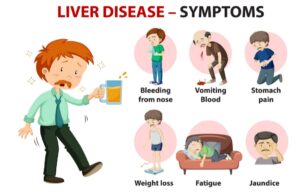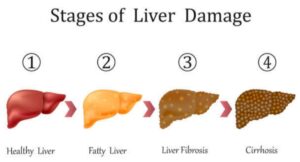- The liver is the largest solid organ in the body, weighing on average about 3.5 pounds.
- The liver carries out a large number of critical functions, including manufacture of essential proteins, and metabolism of fats and carbohydrates.
- The liver also serves to eliminate harmful biochemical waste products and detoxify alcohol, certain drugs, and environmental toxins.
- The liver forms and secretes bile that contains bile acids to aid in the digestion and intestinal absorption of fats and the fat-soluble vitamins A, D, E, and K.
- It helps you digest food, convert it to energy, and store that energy for future use. It also plays an important role in filtering toxic substances out of your blood.
-
What Does the Liver Do?
The liver has a multitude of important and complex functions. Some of these functions are to:
- Manufacture (synthesize) proteins, including albumin (to help maintain the volume of blood) and blood clotting factors
- Synthesize, store, and process (metabolize) fats, including fatty acids (used for energy) and cholesterol
- Metabolize and store carbohydrates, which are used as the source for the sugar (glucose) in blood that red blood cells and the brain use
- Form and secrete bile that contains bile acids to aid in the intestinal absorption of fats and the fat-soluble vitamins A, D, E, and K.
- Eliminate, by metabolizing and/or secreting, the potentially harmful biochemical products produced by the body, such as bilirubin from the breakdown of old red blood cells, and ammonia from the breakdown of proteins
- Detoxify, by metabolizing and/or secreting, drugs, alcohol, and environmental toxins
What are the signs and symptoms of liver disease?
Acute and chronic liver diseases can interfere with the functions of the liver and thereby cause symptoms. Chronic liver disease often won’t cause
LIVER DISEASE - Jaundice (yellow skin) that can occur when the liver is unable to properly metabolize or secrete the yellow pigment bilirubin in bile
- Bleeding or easy bruising that can occur when the liver is unable to make enough of the normal blood clotting proteins
- Swelling of the legs with fluid (edema) that can occur when the liver is unable to make enough albumin and the serum albumin gets too low
- Fatigue that is of unknown cause, but may be related to some impaired metabolic function of the liver
-
Upper abdominal pain.
-
Nausea or loss of appetite.
-
Dark-colored pee (urine).
-
Light-colored poop (stool).
-
Digestive difficulties, especially with fats.
-
Weight loss and muscle loss.
-
Musty-smelling breath.
-
Mild brain impairment (hepatic encephalopathy).
-
Pruritus (itchy skin, but with no visible rash).
What are the stages of chronic liver disease?
Chronic liver disease progresses in roughly four stages:
- Hepatitis.
- Fibrosis.
- Cirrhosis.
- Liver failure.
STAGES OF LIVER DISEASE What are the causes of liver disease?
There are over 100 types of liver disease, but they fall into a handful of subtypes. Causes include:
- Viral infections. Viral hepatitis infections that become chronic can cause chronic hepatitis, including hepatitis B and hepatitis C.
- Alcohol-induced hepatitis. Heavy alcohol use can cause acute or chronic hepatitis. If it goes on long enough, it can cause cirrhosis and liver failure.
- Toxic hepatitis. Chronic overexposure to toxins, such as industrial chemicals or drugs, can cause acute or chronic hepatitis.
- Non-alcohol related fatty liver disease. Metabolic conditions associated with obesity, high blood sugar and high blood lipids can cause excess fat storage in your liver, which can cause inflammation (non-alcohol related steatohepatitis).
- Biliary stasis. Congenital (present at birth) conditions that obstruct or stall the flow of bile through your bile ducts can cause bile to build up and injure your liver, including biliary atresia and cystic fibrosis. Non-congenital causes include biliary stricture and gallstones.
- Autoimmune diseases. Autoimmune conditions can cause chronic inflammation and scarring in your liver or your bile ducts, including autoimmune hepatitis, primary biliary cholangitis and primary sclerosing cholangitis.
- Inherited metabolic disorders. Disorders that cause toxic products to build up in your blood — such as glycogen storage disease (GSD), Wilson disease, hemochromatosis and Gaucher disease — can cause chronic liver damage.
- Cardiovascular diseases. Conditions that affect blood flow to and from your liver — including Budd-Chiari syndrome, ischemia, arterial diseases and right-sided heart failure — can cause chronic liver damage.
What are the risk factors for acquiring liver disease?
You might have a high risk of developing liver disease if you:
- Drink alcohol heavily.
- Use intravenous drugs.
- Use pain relievers like aspirin or acetaminophen
- Have metabolic syndrome.
- Are regularly exposed to toxic chemicals.
Diagnosis and Tests
-
Blood tests. A panel of liver function tests can show signs of liver disease, liver disease severity and liver failure. These measure liver products like liver enzymes, proteins and bilirubin levels in your blood. Blood tests may also indicate inflammation, specific diseases or side effects, like reduced blood clotting.
-
Imaging tests. An abdominal ultrasound, CT scan (computed tomography scan) or MRI (magnetic resonance imaging) can show the size, shape and texture of your liver. This can reveal inflammation and swelling, growths and fibrosis.
-
Elastography. A special type of imaging test called elastography uses ultrasound or MRI technology to measure the level of stiffness or fibrosis in your liver.
-
Endoscopy. If your provider needs to see inside your biliary tract, they might need to use a type of endoscopic imaging. Endoscopy involves passing a tiny camera (endoscope) through your upper GI tract. From the endoscope, they can use EUS or ERCP to see your bile ducts.
-
Nuclear medicine imaging. A nuclear liver and spleen scan uses a gamma camera to detect a (harmless) radioactive tracer material that’s injected into your body. How your liver absorbs the tracer will highlight the areas that aren’t functioning normally.
-
Liver biopsy. A liver biopsy is a minor procedure to take a small tissue sample from your liver to test in a lab. A healthcare provider can usually take the sample through a hollow needle. You might need a liver biopsy to check for cancer or confirm cirrhosis and help determine the cause. Diseases that may affect the liver include hepatitis (inflammation of the liver), cirrhosis (scarring), fatty liver, and liver cancer (hepatocellular carcinoma)
Treatment
Lifestyle changesMaking lifestyle changes can significantly improve liver health. After diagnosis, a liver specialist may recommend quitting alcohol and avoiding certain foods like red meat, trans fats, processed carbs, and high-fructose fat. Lifestyle changes might also include moderate exercise for 30 to 60 minutes, two to three times a week. For obese patients, reducing 500 to 1,000 calories daily may be advised.
The liver specialist may also suggest avoiding certain dietary or herbal supplements to reduce scarring. It’s crucial to discuss potential risks with the specialist before making any changes to diet or lifestyle.
DIET FOR LIVER DISEASE
To address liver problems, the specialist may tailor the diet based on individual needs:
- Food to avoid: Stay away from foods high in fat, sugar, and salt, as well as fried foods, fast food, and unhealthy snacks. Avoid raw or undercooked meats altogether.
- Quit alcohol: Alcohol damages the liver. Upon diagnosis, it’s essential to quit immediately. If the condition isn’t severe, moderate alcohol consumption may be allowed but only after consulting the specialist.
- Stay hydrated: Drink plenty of water to prevent dehydration and support liver function.
- Balanced diet: Maintain a healthy diet that includes grains, vegetables, fruits, meat, beans, dairy, and healthy oils.
- High-fiber diet: A fiber-rich diet helps the liver function optimally. Include fruits, vegetables, whole-grain bread, rice, and cereals in your meals.


drmayurikokare.com 16 Jul 2025
THANK YOU FOR READING THE BLOG